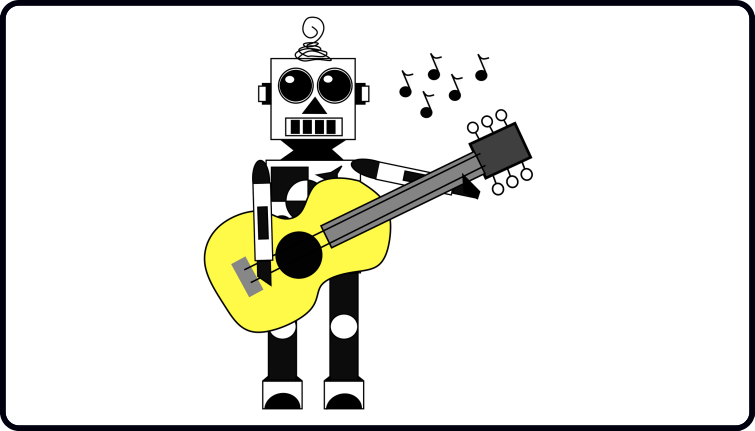I have something a little different for you today.
It’s a guitar lesson from the robots of the future.
Well, kind of…
In case you don’t know, AI or Artificial Intelligence is getting bigger all the time.
Some say the world is changing daily because of it and the future of learning is going to change dramatically.
So, I thought I’d ask the AI robots some ways they think you should learn guitar.
This is what the infamous Chat GPT AI said:
1 – You should start with electric guitar, not acoustic. Electric guitars are easier to play, more motivating for students, and can lead to quicker progress.
Electrics can be easier to play for the fretting hand, but for fingerpickers, they can be awkward (due to the strings being closer together).
The tone of an electric may not be to your taste if you prefer the sound of an acoustic. I often encourage students to get an electric at some point for fun if they like the sound of them…
…But if you’re mainly an acoustic player, the key thing is you get the best acoustic you can for you.
The bottom line: What’s the point in learning on an electric if you’re not inspired to play it?
2 – Guitar teachers should not teach songs that students want to learn. Teachers should focus on foundational skills and not cater to students’ song preferences to build a strong musical foundation.
If you want students to lose motivation, then sure, go ahead and teach them things that kill off their inspiration faster than a T-1000 chasing down John Conner from the Terminator movies.
When I first started teaching full time, a good chunk of my students came to me because a local tutor was doing that exactly. Students didn’t like it, hence why they left him.
The bottom line: You can learn core technique AND the songs you love.
3 – Music theory should be introduced later in a student’s guitar education. Pushing theory too early can overwhelm beginners, and it should be introduced after they have developed basic playing skills.
I agree to a degree. If you start learning theory without putting it into practice, it is hard to connect the dots and make sense of it. It’s like learning a language but never speaking it.
Saying that some people are not taught any theory at all or wait way too long. A little theory can go a long way.
The bottom line: Develop your skills, but a small amount of theory learnt early on can be a very good thing.
4 – Online lessons and YouTube tutorials are superior to in-person instruction. The flexibility, variety, and accessibility of online resources make them a better choice for learning the guitar, rendering traditional lessons obsolete.
Woah, steady on C3PO.
If you have a great online teacher who has a plan, fixes your bad habits, and teaches you what you need, then yes, that is great. It is far better than an in-person tutor who shows up late, drinks beer during the lesson and shows off his favourite Santana solos while you sit there thinking, “What the heck am I paying for?”
On the flipside, a great in-person tutor is obviously better than a YouTube teacher who has 3,426 songs on his channel, but zero advice on technique or no plan on learning the instrument.
The bottom line: It’s all about the person teaching you, not the medium they use.
5 – Guitar teachers should avoid correcting a student’s technique if it’s working for them. Individuality in technique can lead to unique playing styles and should be encouraged, even if it deviates from traditional methods.
Individuality is a great thing, but I prefer students to develop their own style of playing when they have great core technique.
Playing with bad habits or awkward movements is not the way to be individual.
I believe individuality comes from the creative elements and not the technical elements of playing.
A lot of great players do things in their own way technically and creatively.
That shows you can get away with doing whatever, but even those players often admit they could potentially be better able to express themselves with a few tweaks to their technique.
The bottom line: Be individual, be creative, and develop your own style, but not at the expense of good “Core Fundamental Technique”.
Anyway, there you go.
You may agree or disagree with these points.
Let me know who is right, the robots or yours truly.
Are the robots coming for my job?
In a few years, will I be forced to tune R2D2’s guitar strings while he does the teaching?
(Oh no, the robots will be able to do that themselves).
The world is changing but I think I’ll be alright, haha.
Anyway, this was a bit of fun and I hope this gave you something to think about.
It’s always useful to challenge beliefs and methods and think about them critically.
If you enjoyed this email, let me know (I might write a follow-up)
In the meantime, for more help with the things mentioned in this email, including technique, getting a solid plan, fixing bad habits, and much more, you might like to check this out…
Fingerstyle 101 – a step-by-step guide to beautiful fingerpicking guitar playing
Enjoy and beware of the killer guitar robots!
Dan Thorpe
Guitar Domination
P.S. This post was originally taken from Dan Thorpe’s private email list. To get blog posts like this sent to you which are full of great tips to make fingerpicking, strumming, and learning guitar more enjoyable (especially if you are over 40) join Dan’s list. It’s 100% free, HERE.


Add Comment